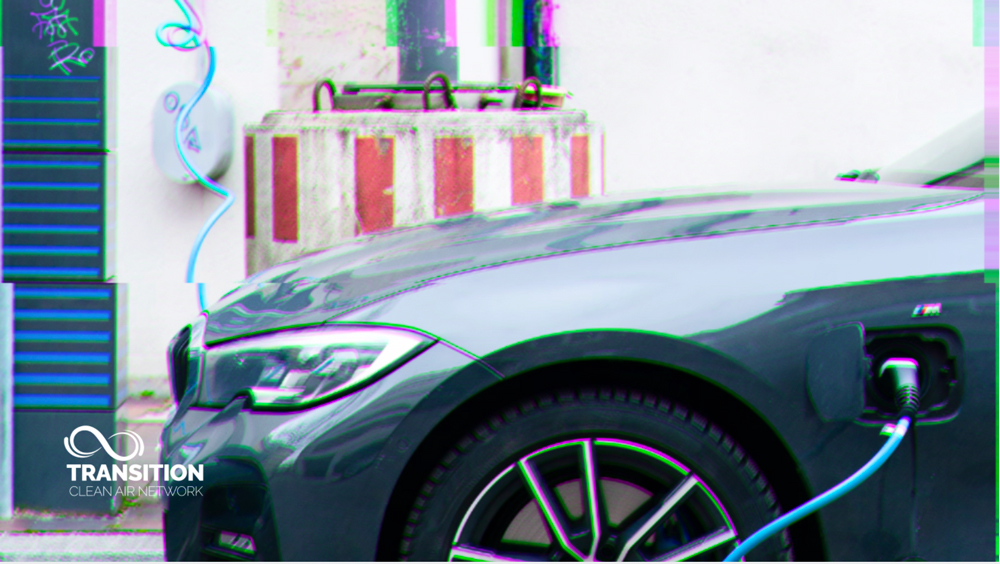26 Nov 2021
At COP26, the UK Government was one of 38 national governments (in addition to local/regional governments, automotive manufacturers, fleet owners/operators and investors) to sign the ‘Glasgow Declaration’[1] committing themselves to a rapid acceleration of the transition to ‘zero emission vehicles’, motivated by the goals of the Paris Agreement.[2] Whilst we broadly welcome the transition from fossil-fueled vehicles to 100% electric vehicles (EVs), EVs are far from a climate change or clean air panacea, and must not be presented as such. EVs are not Net Zero unless all EV parts, production and recycling are Net Zero and all electricity generation and distribution is Net Zero – and EVs still emit non-exhaust emissions. The TRANSITION Clean Air Network’s express concerns are:
1. The UK Government’s focus on the shift to EVs, to the near-exclusion of modal shift towards still cleaner and more sustainable modes of transport, namely public transport and active travel. The latter offers major additional benefits for public health and quality of life via reduced road traffic collisions, increased levels of physical activity and improved mental health.
2. The misleading description of EVs as ‘zero emission vehicles’ that neglects their non-exhaust emissions (including, not only their direct emissions from brake, tyre and road wear, but also all emissions associated with electricity generation and EV manufacturing) and the impacts of these on both climate and air quality: only by reducing both exhaust and non-exhaust emissions, will we capitalise on the full co-benefits of Net Zero for air quality and public health, as well as climate.
3. The further risks the term, ‘zero emissions vehicles’, poses to the development of valuable alternatives to EVs (e.g., vehicles powered by hydrogen-fuel cells, e-fuels and sustainable bio-fuels) and broader mixes of vehicle-power technologies in pursuit of Net Zero.
4. The clear omission of a discussion around system efficiency, and how this can be improved by reconsidering the vehicle production-consumption nexus: the requirement should not end at cleaner, but also less energy intensive across a vehicle’s whole life cycle: i.e., target reduction of material and energy use* to produce smaller and lighter vehicles (appropriate to use case); target intensified use of correspondingly fewer vehicles to reduce production demands; and target efficient recycling (maximising reclamation/reuse of materials and minimising energy expended in the process) via intelligent vehicle design.
*In a Full Life Cycle Assessment, Polestar estimates that an EV (Polestar 2) must be driven 50,000-112,000 km just to save the CO2 embedded in its manufacture.[3]
5. The additional lack of impetus to reduce the size and weight of EVs: over-engineering increases, not only material and energy consumption, but also the weight of EVs and consequently their non-exhaust emissions from brake, tyre and road wear.[4]
6. The absence of options to deliver a wider range of benefits, faster[5], for both climate and air quality, by reducing the need to travel such as increased home working, use of digital technologies, public transport and car sharing: COVID-19 lockdowns demonstrated the scale of changes in vehicle travel achievable on short timescales, if we are prepared to make bigger policy and behavioural changes, sooner [6,7]; and, technologically, transitional efforts should be focussed on repairing, retrofitting and/or replacing the most polluting vehicles first.[8]
7. The lack of commitment at the outset to prioritise reductions in vehicle emissions (exhaust and non-exhaust) in the vicinity of vulnerable populations: deprived communities are, on average, exposed to more vehicular pollution and more vulnerable to its health impacts.
8. The further lack of consideration for inclusivity, accessibility and remediation (cf. widening) of existing inequalities with regards to UK mobility. Lowest income households show lower car ownership (40% of these have no car access[9]); female household heads, children, younger/older people, black and minority ethnic (BAME) demographics and disabled people are concentrated in these disadvantaged households. Children, the elderly and people with certain pre-existing medical conditions are also more vulnerable to the health impacts of air pollution.
This is a once in a generation opportunity to reduce further climate change and improve air quality for the betterment of the UK’s public health, economy and environment. We are currently at risk of not realising the full benefits achievable.
Signatories on behalf of the TRANSITION Clean Air Network:
Dr James Levine, Innovation Network Manager, University of Birmingham
Dr Suzanne Bartington, Principal Investigator, University of Birmingham
Prof Sam Akehurst, Academic Co-Investigator, University of Bath
Prof William Bloss, Academic Co-Investigator, University of Birmingham
Dr Huw Davies, Academic Co-Investigator, University of Coventry
Prof Nigel Gilbert, Academic Co-Investigator, University of Surrey
Dr Ian Hamilton, Academic Co-Investigator, University College London
Dr Stuart Hillmansen, Academic Co-Investigator, University of Birmingham
Dr Felix Leach, Academic Co-Investigator, University of Oxford
Prof Martin Mayfield, Academic Co-Investigator, University of Sheffield
Dr Sarah Moller, Academic Co-Investigator, University of York
Prof Francis Pope, Academic Co-Investigator, University of Birmingham
Dr Karl Ropkins, Academic Co-Investigator, University of Leeds
Kayla Schulte, Engagement Officer, University of Oxford
Dr Alexandra Penn, Senior Research Fellow (ANTICIPATE, CECAN), University of Surrey
Notes
[1] COP26 Declaration on accelerating the transition to 100% zero emission cars and vans, Policy Paper Published 10 November 2021, Available at: https://www.gov.uk/government/publications/cop26-declaration-zero-emission-cars-and-vans/cop26-declaration-on-accelerating-the-transition-to-100-zero-emission-cars-and-vans
[2] The Paris Agreement, United Nations Climate Change, A legally binding international treaty on climate change adopted by 196 Parties at COP21 in Paris, Available at: https://unfccc.int/process-and-meetings/the-paris-agreement/the-paris-agreement
[3] Polestar, Life cycle assessment – Carbon footprint of Polestar 2, Available at: https://www.polestar.com/dato-assets/11286/1600176185-20200915polestarlcafinala.pdf
[4] Allwood, J., et al. (2012) Sustainable materials: with both eyes open. Cambridge, UK: UIT Cambridge Limited, Available at: https://www.cisl.cam.ac.uk/resources/natural-resource-security-publications/julian-allwood-sustainable-materials
[5] Racing Toward Zero: The Untold Story of Driving Green, K. Senecal and F. Leach (2021), SAE International, ISBN 978-1-4686-0146-6, Available at: https://www.sae.org/publications/books/content/r-501/
[6] Monks, P. (2020) Coronavirus: lockdown’s effect on air pollution provides rare glimpse of low-carbon future, 15 Apr 2020, The Conversation, Available at: https://theconversation.com/coronavirus-lockdowns-effect-on-air-pollution-provides-rare-glimpse-of-low-carbon-future-134685
[7] Winfree. G. and Zietsman, J. (2020) COVID-19 and the Future of Transportation, Available at: https://www.carteeh.org/wp-content/uploads/2020/05/Impact-of-COVID-19-on-Transportation.pdf
[8] Huang, Y., et al. (2020) Re-evaluating effectiveness of vehicle emission control programmes targeting high-emitters, Nature Sustainability, 3(11), pp.904-907, Available at: https://doi.org/10.1038/s41893-020-0573-y
[9] Government Office for Science Inequalities in Mobility and Access in the UK Transport System (2019) Available at: https://assets.publishing.service.gov.uk/government/uploads/system/uploads/attachment_data/file/784685/future_of_mobility_access.pdf
Download
- This letter is available for download in pdf.

